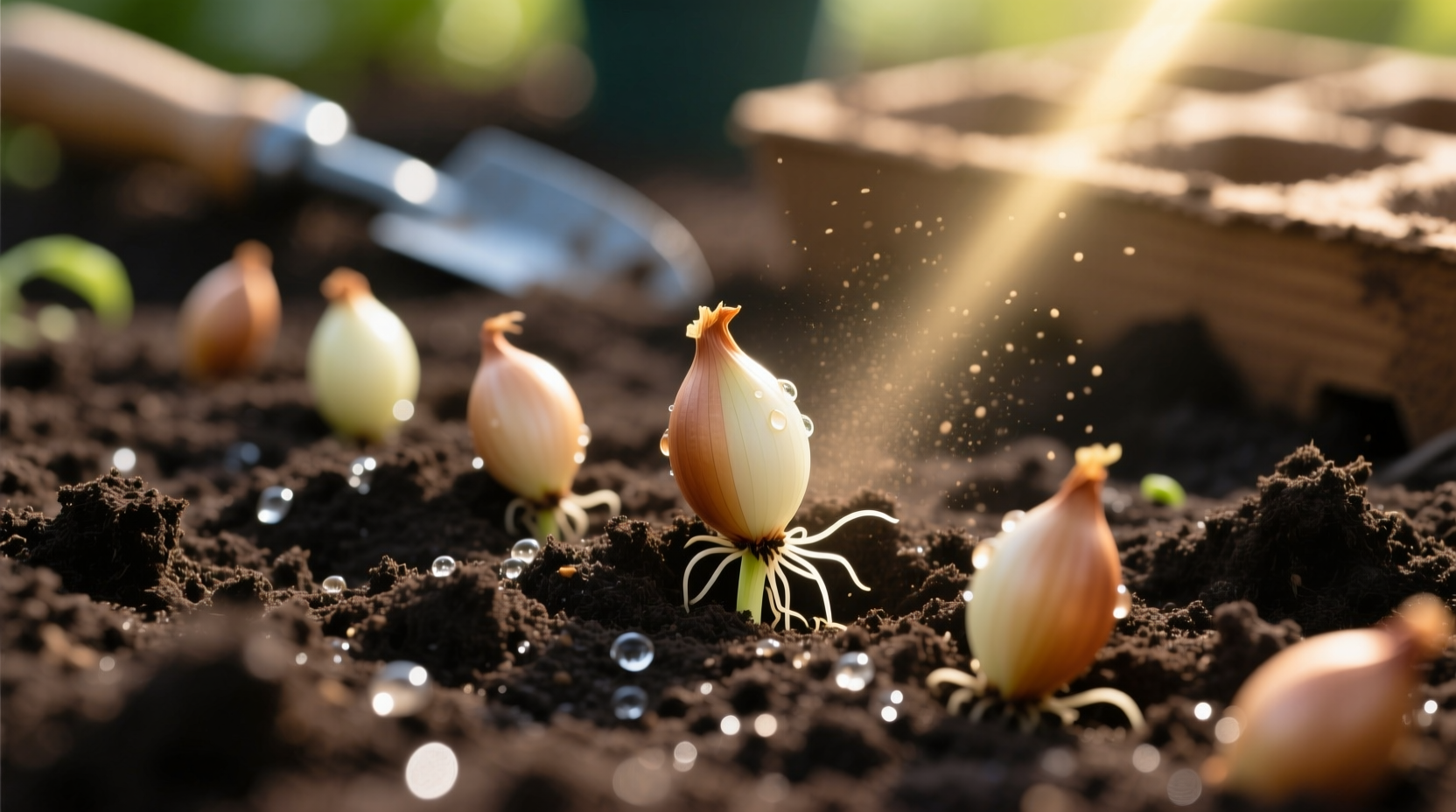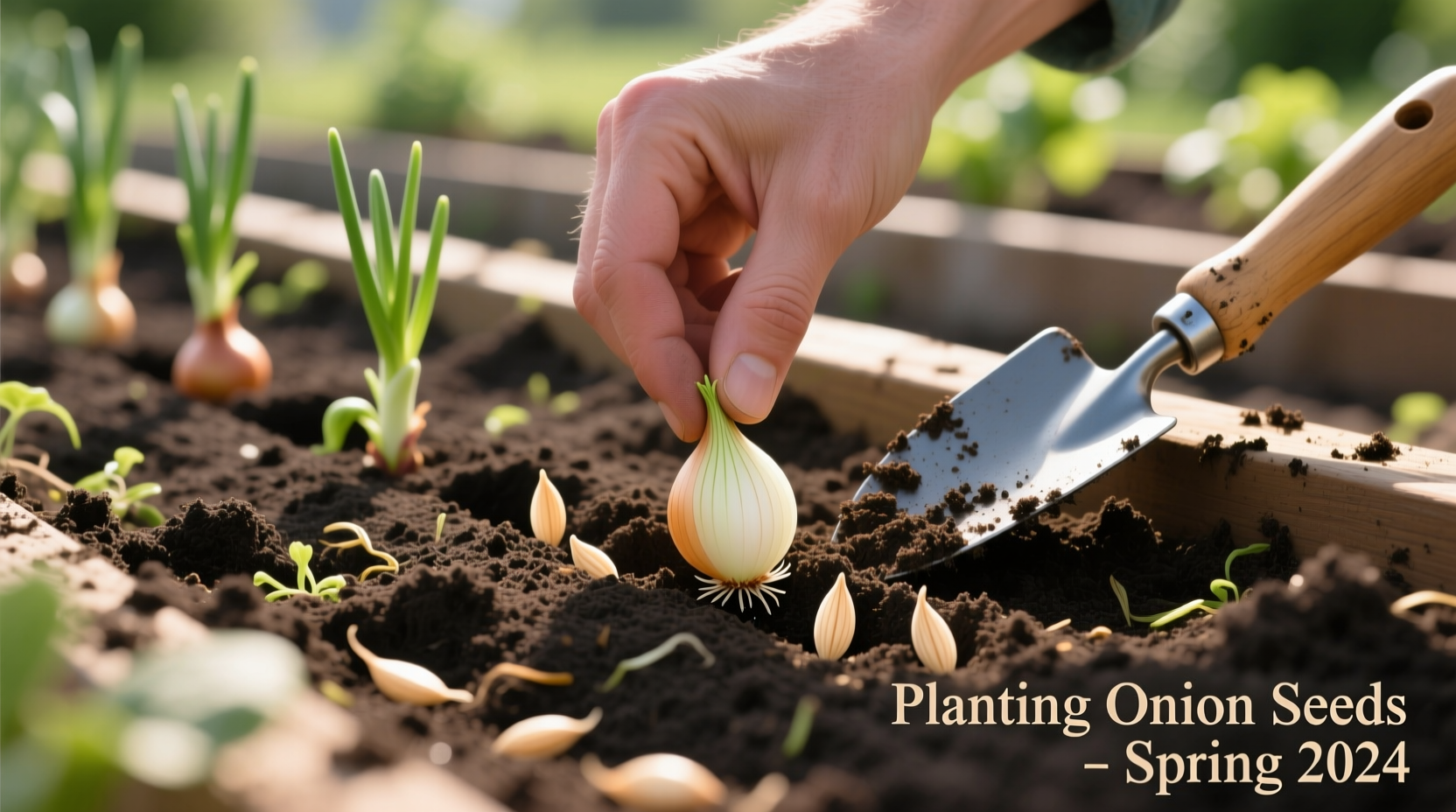Ready to grow your own onions from seed? This comprehensive guide delivers exactly what beginner and intermediate gardeners need to successfully plant onion seeds for a bountiful harvest. You'll discover precise timing strategies, soil preparation techniques, and care methods that professional growers use to achieve maximum bulb size and flavor development—all backed by agricultural research and field-tested practices.
Why Start Onions from Seed Instead of Sets?
While onion sets offer convenience, seeds provide significant advantages for home gardeners. According to the Oregon State University Extension Service, starting from seed gives you access to 300+ varieties compared to the limited selection of sets available at garden centers. Seeds also eliminate the risk of bolting (premature flowering) that commonly affects sets, particularly in warmer climates.
| Planting Method | Variety Selection | Bolting Risk | Cost per Plant |
|---|---|---|---|
| Seeds | 300+ varieties | Low | $0.03 |
| Sets | 5-10 varieties | High | $0.25 |
| Transplants | 20-30 varieties | Medium | $0.15 |
Planning Your Onion Seed Planting Timeline
Timing determines your onion success more than any other factor. The USDA Agricultural Research Service recommends these planting windows based on your climate zone:
- Cold climates (Zones 3-5): Start seeds indoors 10-12 weeks before last frost, transplant outdoors 2-4 weeks before last frost
- Temperate climates (Zones 6-7): Start seeds indoors 8-10 weeks before last frost, direct sow 4 weeks before last frost
- Warm climates (Zones 8-10): Direct sow in fall for overwintering, or start seeds indoors 6-8 weeks before first fall frost
Day length sensitivity is crucial—onions fall into three categories based on how many daylight hours trigger bulb formation:
- Short-day onions (10-12 hours): Best for southern regions, plant in fall
- Intermediate-day onions (12-14 hours): Suitable for mid-latitudes, plant in early spring
- Long-day onions (14+ hours): Ideal for northern regions, plant as soon as soil can be worked
Soil Preparation: Creating the Perfect Onion Bed
Onions demand well-prepared soil for optimal root development. Research from Cornell University's College of Agriculture shows onions grown in properly amended soil produce bulbs 35% larger than those in unamended soil.
Follow these soil preparation steps 2-3 weeks before planting:
- Test soil pH and amend to reach 6.0-7.0 (onions struggle below 5.5 or above 7.5)
- Incorporate 3-4 inches of compost or well-rotted manure
- Add 1 pound of 10-10-10 fertilizer per 100 square feet
- Create raised beds 4-6 inches high for improved drainage

Step-by-Step Planting Process
Whether starting indoors or direct sowing, follow these research-backed planting techniques:
Indoor Seed Starting (Recommended for Most Climates)
- Fill seed trays with sterile seed starting mix
- Sow 3-4 seeds per cell 1/4 inch deep
- Water gently and maintain soil temperature at 70°F (21°C)
- Provide 14-16 hours of light daily once germination occurs (5-12 days)
- Thin to strongest seedling per cell when 2 inches tall
- Harden off seedlings for 7-10 days before transplanting
Direct Sowing (Best for Warmer Climates)
- Prepare soil as described above
- Create shallow furrows 1/4 inch deep
- Sow seeds 1 inch apart in rows 12-18 inches apart
- Cover lightly with soil and water gently
- Maintain consistent moisture until germination
- Thin seedlings to 3-4 inches apart when 4 inches tall
Critical Care After Planting
Onion seedlings require specific care during their first 6 weeks to establish strong root systems:
- Watering: Maintain consistent moisture (1 inch per week), avoiding both drought stress and waterlogging
- Weeding: Hand-pull weeds carefully—onion roots are shallow and easily damaged
- Fertilizing: Apply nitrogen-rich fertilizer when tops reach 6 inches, then every 2-3 weeks until bulbing begins
- Pest prevention: Use floating row covers to protect against thrips and onion maggots
The University of Minnesota Extension notes that inconsistent watering during the early growth stage is the leading cause of small bulb size, as onions require steady moisture to develop properly before the bulbing phase.
Common Planting Mistakes to Avoid
Even experienced gardeners make these critical errors when planting onion seeds:
- Planting too deep: Seeds planted deeper than 1/2 inch often fail to germinate properly
- Overcrowding: Failure to thin seedlings results in small, misshapen bulbs
- Incorrect variety selection: Choosing long-day varieties in southern climates causes poor bulb formation
- Planting too early: Cold soil below 50°F (10°C) leads to poor germination and seed rot
- Neglecting soil pH: Onions in acidic soil often develop nutrient deficiencies
Expected Timeline to Harvest
Understanding the growth stages helps you provide appropriate care at each phase:
- Weeks 1-2: Germination and initial root development
- Weeks 3-6: Top growth and root system establishment
- Weeks 7-12: Bulb initiation and early development
- Weeks 13-20: Bulb enlargement (critical watering phase)
- Weeks 21-24: Maturation and harvest preparation
Most onion varieties reach maturity 90-120 days after planting, depending on variety and growing conditions. Watch for the tops to naturally fall over as the harvest signal.
Frequently Asked Questions
How deep should I plant onion seeds?
Plant onion seeds 1/4 inch deep in loose soil. Planting deeper than 1/2 inch significantly reduces germination rates, as shown in agricultural studies from Cornell University's horticulture department. In heavy clay soils, plant slightly shallower at 1/8 inch to ensure successful emergence.
Can I plant onion seeds directly in the garden?
Yes, you can direct sow onion seeds when soil temperature reaches 50°F (10°C), typically 4-6 weeks before your last frost date. However, starting seeds indoors gives you a 3-4 week head start, which is crucial for long-day varieties in northern climates. Direct sowing works best in regions with longer growing seasons (Zones 6 and warmer).
How far apart should I space onion seeds?
Initially plant seeds 1 inch apart in rows. After germination, thin seedlings to 2-3 inches apart for green onions or 3-4 inches apart for full-sized bulbs. Research from Oregon State University shows proper spacing increases bulb size by up to 40% compared to overcrowded plantings, as onions need adequate space for bulb development.
How long do onion seeds take to germinate?
Onion seeds typically germinate in 5-12 days when soil temperature is maintained at 70°F (21°C). Germination slows significantly in cooler soils—at 50°F (10°C), it may take 2-3 weeks. Keep soil consistently moist but not waterlogged during germination, as drying out can kill emerging seedlings.
Why are my onion seedlings falling over?
Seedlings falling over usually indicates damping-off disease, caused by fungal pathogens in cool, wet soil. Prevent this by using sterile seed starting mix, providing good air circulation, avoiding overwatering, and using bottom heat to maintain soil temperature above 65°F (18°C). If damping-off occurs, remove affected seedlings immediately and apply a chamomile tea solution as a natural fungicide.











 浙公网安备
33010002000092号
浙公网安备
33010002000092号 浙B2-20120091-4
浙B2-20120091-4